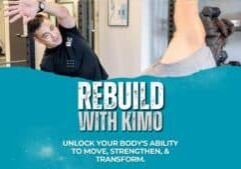Corrective exercises have gained popularity in recent years as a vital component of injury recovery. These exercises are designed to address imbalances, improve flexibility, and strengthen specific muscle groups. But how effective are they in promoting recovery from injuries? This blog will explore the role of corrective exercises in injury recovery, examining their benefits, the science behind them, and practical applications for individuals looking to restore their health and functionality.
Understanding Corrective Exercises
Corrective exercises are physical activities designed to target specific weaknesses or imbalances in the body. They focus on improving overall alignment, function, and biomechanics. These exercises serve a crucial role in injury recovery by promoting proper movement patterns, which helps to prevent the risk of further injuries. Many individuals may associate exercise strictly with building strength or endurance; however, corrective exercises target the finer details of musculoskeletal function.
Typically, corrective exercises aim to enhance mobility and stability through tailored routines. For instance, a common corrective exercise may include hip flexor stretches for someone suffering from lower back pain, as tight hip flexors can contribute to this discomfort. Furthermore, these exercises help individuals to develop awareness of their body mechanics, leading to improved postural habits that benefit them not just during recovery but in their daily activities as well.
The Science Behind Injury Recovery
A growing body of research supports the efficacy of corrective exercises in promoting injury recovery. Studies have shown that controlled movement encourages the healing process by increasing blood flow to affected areas. Enhanced circulation provides essential nutrients and oxygen to tissues, which is critical in the recovery phase. Additionally, research has indicated that corrective exercises can effectively reduce pain, improve mobility, and restore function in various musculoskeletal injuries.
The mind-body connection plays a significant role in injury recovery as well. Engaging in corrective exercises necessitates mental focus and physical coordination, creating an environment where mental barriers can be overcome. As patients actively participate in their recovery, they not only see improvements in their physical well-being but also gain confidence in their abilities. This interplay between the mind and body can be a powerful motivator for individuals going through the rehabilitation process.
Furthermore, the principles of biomechanics provide a framework for understanding how corrective exercises facilitate recovery. By analyzing movement patterns, therapists can identify maladaptive behaviors that contribute to injury and develop strategies to correct them. Through targeted interventions that emphasize optimal movement mechanics, individuals can achieve more effective recovery outcomes, making this approach not just beneficial but essential.
Benefits of Corrective Exercises in Recovery
The multifaceted benefits of incorporating corrective exercises into injury recovery programs extend beyond mere physical improvement. One of the primary advantages is the promotion of long-term well-being; by addressing underlying issues, individuals are more likely to prevent future injuries. As they restore function, they develop crucial strength and flexibility needed for their specific activities, whether in sports or everyday life.
Another benefit lies in the psychological aspect of recovery. Engaging in corrective exercises can significantly reduce feelings of frustration or helplessness associated with injuries. As individuals see measurable progress, their confidence in their bodies begins to return, which is often a crucial requirement for full recovery. This emotional boost can create a positive feedback loop, encouraging further commitment to the rehabilitation process.
Corrective exercises also foster a more profound understanding of one’s body mechanics. This awareness equips individuals with the knowledge to modify their movements and activities better, promoting overall resilience against future injuries. It’s about empowering them to take control of their rehabilitation, leading to a more engaged and proactive approach to their health.
In essence, the benefits of corrective exercises are holistic, addressing physical, psychological, and educational facets of injury recovery, laying the groundwork for a thorough recovery process that can yield lasting results.
Implementing Corrective Exercises into Your Routine
Integrating corrective exercises into daily routines requires a thoughtful approach tailored to the individual’s needs. A structured plan should begin with a comprehensive assessment to identify specific areas that require attention. This assessment can either be performed by a qualified healthcare professional or a dedicated practitioner who understands the intricate relationship between movement and injury recovery.
Once the assessment is complete, individuals can start with simple exercises that focus on flexibility and mobility. Gradually, they should progress to strength-building exercises that not only target the injured area but also promote stability in surrounding muscle groups. A well-rounded routine that includes these corrective exercises should ideally be complemented by complementary strategies, such as proper warm-up routines, cooldown stretches, and even relaxation techniques like yoga or pilates.
To maintain motivation, individuals can establish measurable goals and track their progress over time. As they achieve milestones, whether it’s improved range of motion, reduced pain, or the ability to perform daily tasks with ease, they reinforce their commitment to the rehabilitation process. Furthermore, working with a therapist or trainer can provide accountability and professional guidance, ensuring that exercises are performed correctly and effectively to maximize recovery.
Common Misconceptions About Corrective Exercises
Despite their growing popularity, several misconceptions about corrective exercises persist. One common myth is that corrective exercises are only for athletes. On the contrary, these exercises can benefit anyone, regardless of activity level or age. In fact, individuals who engage in regular physical activity may find themselves at a higher risk of injury if specific weaknesses or imbalances are not addressed, making corrective exercises essential for holistic well-being.
Another misconception is that corrective exercises provide an instant fix. While they can yield improvements, their effectiveness relies on consistent practice and patience. Recovery is a gradual process, and implementing corrective exercises can pave the way for improvements, but they are part of a larger rehabilitation strategy that includes various modalities. Expecting immediate results can set individuals up for disappointment, as real progress often takes time.
Lastly, there is often a belief that corrective exercises are too simplistic to be effective. However, their effectiveness lies precisely in their simplicity; these exercises focus on restoring fundamental movement patterns rather than complex workouts that may not be tailored to individual issues. Embracing these straightforward yet impactful exercises can lead to substantial improvements over time.
Real-Life Success Stories
Many individuals have experienced remarkable recoveries through the implementation of corrective exercises. For instance, a former athlete faced severe knee pain after years of high-intensity training. After an assessment, a tailored program focusing on hip stabilizers and quadricep strengthening was developed. Over several months, the individual not only reduced knee pain significantly but also improved their overall athletic performance, demonstrating the powerful impact of corrective exercises.
In another example, a busy professional who had been suffering from chronic back discomfort due to extended hours of desk work found relief through a dedicated routine of corrective exercises. By addressing muscle imbalances that had developed due to prolonged sitting, the individual regained mobility and reduced pain levels. This transformation allowed them to return to hobbies they had previously given up, showcasing how corrective exercises can lead to holistic life changes.
These success stories underscore the importance of recognizing the potential of corrective exercises in aiding injury recovery. Each individual’s journey is unique, yet the common thread remains the empowerment found in taking an active role in their healing process. With the right approach and commitment, anyone can work towards overcoming their injuries and fully restoring their health.
Final Thoughts on Corrective Exercises
In summary, the integration of corrective exercises into injury recovery programs can significantly enhance the healing process by addressing root causes of pain and dysfunction. While they are not a standalone solution, when combined with appropriate rehabilitation strategies, these exercises can lead to improved outcomes for those recovering from injuries. Ultimately, a tailored approach considering individual needs can provide the best results in injury recovery.
Injury-Proof Your Body: How the REBUILD Program Can Help You Prevent Future Pain and Injury
We all know the frustration of an injury that sidelines us from the activities we love. Whether it’s a nagging backache that keeps you from your favorite sport or a sudden sprain that throws off your daily routine, pain and limitations can significantly impact our quality of life. But what if there was a way…
Read MoreBalancing Act: The Impact of Sports Injury Clinics on Work-Life Balance.
Explore how a sports injury clinic can improve your work-life balance in our blog ‘Balancing Act: The Impact of Sports Injury Clinics on Work-Life Balance’.
Read MoreAre Corrective Exercises Effective in Injury Recovery?
Explore the effectiveness of corrective exercises in injury recovery in our blog ‘Are Corrective Exercises Effective in Injury Recovery?’
Read MoreAdvanced Chiro Rehab Techniques: A Revolution in Pain Management
Discover groundbreaking chiro rehab techniques transforming pain management in our blog ‘Advanced Chiro Rehab Techniques: A Revolution in Pain Management’.
Read MoreUnderstanding the Importance of Spinal Rehab for Back Pain
Discover the crucial role of spinal rehab in managing back pain in our insightful blog ‘Understanding the Importance of Spinal Rehab for Back Pain’.
Read MoreExercises You Can Do at Home after a Visit to the Chiropractic Clinic
Stay active at home with exercises from ‘Exercises You Can Do at Home after a Visit to the Chiropractic Clinic’.
Read More






